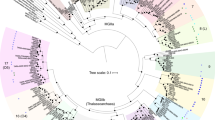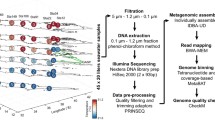Abstract
Most microbial groups have not been cultivated yet, and the only way to approach the enormous diversity of rhodopsins that they contain in a sensible timeframe is through the analysis of their genomes. High-throughput sequencing technologies have allowed the release of community genomics (metagenomics) of many habitats in the photic zones of the ocean and lakes. Already the harvest is impressive and included from the first bacterial rhodopsin (proteorhodopsin) to the recent discovery of heliorhodopsin by functional metagenomics. However, the search continues using bioinformatic or biochemical routes.
Access this chapter
Tax calculation will be finalised at checkout
Purchases are for personal use only
Similar content being viewed by others
References
Stanier RY, Doudoroff M, Adelberg EA (1971) General microbiology, 3rd edn. Prentice Hall
Krisch HM, Comeau AM (2008) The immense journey of bacteriophage T4—from d’Herelle to Delbruck and then to Darwin and beyond. Res Microbiol 159(5):314–324
Magrum L et al (1975) Corrections in the catalogue of oliogonucleotides produced by digestion of Escherichia coli 16S rRNA with T1 RNase. Nature 257(5525):423–426
Woese CR, Fox GE (1977) Phylogenetic structure of the prokaryotic domain: the primary kingdoms. Proc Natl Acad Sci U S A 74(11):5088–5090
Pace NR et al (1986) The analysis of natural microbial populations by ribosomal RNA sequences. Adv Microb Ecol 9:1–55
Giovannoni SJ et al (1990) Genetic diversity in Sargasso Sea bacterioplankton. Nature 345(6270):60–63
Hugenholtz P, Goebel BM, Pace NR (1998) Impact of culture-independent studies on the emerging phylogenetic view of bacterial diversity. J Bacteriol 180(18):4765–4774
Chisholm SW et al (1992) Prochlorococcus marinus nov. gen. nov. sp.: an oxyphototrophic marine prokaryote containing divinyl chlorophyll a and b. Arch Microbiol 157:297–300
Rippka R et al (2000) Prochlorococcus marinus Chisholm et al. 1992 subsp. pastoris subsp. nov. strain PCC 9511, the first axenic chlorophyll a2/b2-containing cyanobacterium (Oxyphotobacteria). Int J Syst Evol Microbiol 5:1833–1847
Rappé MS et al (2002) Cultivation of the ubiquitous SAR11 marine bacterioplankton clade. Nature 418(6898):630–633
Giovannoni SJ, Cameron Thrash J, Temperton B (2014) Implications of streamlining theory for microbial ecology. ISME J 8(8):1553–1565
Welch RA et al (2002) Extensive mosaic structure revealed by the complete genome sequence of uropathogenic Escherichia coli. Proc Natl Acad Sci U S A 99(26):17020–17024
Tettelin H et al (2005) Genome analysis of multiple pathogenic isolates of Streptococcus agalactiae: implications for the microbial "pan-genome". Proc Natl Acad Sci U S A 102(39):13950–13955
Land M et al (2015) Insights from 20 years of bacterial genome sequencing. Funct Integr Genomics 15(2):141–161
Suzuki MT et al (2004) Phylogenetic screening of ribosomal RNA gene-containing clones in Bacterial Artificial Chromosome (BAC) libraries from different depths in Monterey Bay. Microbial Ecol 48:473–488
Venter JC et al (2004) Environmental genome shotgun sequencing of the Sargasso Sea. Science 304:66–74
Kunin V et al (2008) A bioinformatician’s guide to metagenomics. Microbiol Mol Biol Rev 72(4):557–578, Table of Contents
Haro-Moreno JM et al (2020) Ecogenomics of the SAR11 clade. Environ Microbiol 22(5):1748–1763
Rodriguez-Valera F, Martin-Cuadrado AB, Lopez-Perez M (2016) Flexible genomic islands as drivers of genome evolution. Curr Opin Microbiol 31:154–160
Rondon MR et al (2000) Cloning the soil metagenome: a strategy for accessing the genetic and functional diversity of uncultured microorganisms. Appl Environ Microbiol 66(6):2541–2547
Béjà O et al (2000) Construction and analysis of bacterial artificial chromosome libraries from a marine microbial assemblage. Environ Microbiol 2(5):516–529
Oesterhelt D, Stoeckenius W (1971) Rhodopsin-like protein from the purple membrane of Halobacterium halobium. Nat New Biol 233(39):149–152
Matsuno-Yagi A, Mukohata Y (1977) Two possible roles of bacteriorhodopsin; a comparative study of strains of Halobacterium halobium differing in pigmentation. Biochem Biophys Res Commun 78(1):237–243
Spudich JL, Bogomolni RA (1984) Mechanism of colour discrimination by a bacterial sensory rhodopsin. Nature 312(5994):509–513
Jung KH, Trivedi VD, Spudich JL (2003) Demonstration of a sensory rhodopsin in eubacteria. Mol Microbiol 47(6):1513–1522
Finkel OM, Béjà O, Belkin S (2012) Global abundance of microbial rhodopsins. ISME J 7:448–451
Gómez-Consarnau L et al (2019) Microbial rhodopsins are major contributors to the solar energy captured in the sea. Sci Adv 5:eaaw8855
Fuhrman JA, Schwalbach MS, Stingl U (2008) Proteorhodopsins: an array of physiological roles? Nat Rev Microbiol 6:488–494
Yutin N, Koonin EV (2012) Proteorhodopsin genes in giant viruses. Biol Direct 7:34
Philosof A, Béjà O (2013) Bacterial, archaeal and viral-like rhodopsins from the Red Sea. Environ Microbiol Rep 5:475–482
Needham DM et al (2019) A distinct lineage of giant viruses brings a rhodopsin photosystem to unicellular marine predators. Proc Natl Acad Sci U S A 116(41):20574–20583
Bratanov D et al (2019) Unique structure and function of viral rhodopsins. Nat Commun 10(1):4939
Zabelskii D et al (2020) Viral rhodopsins 1 are an unique family of light-gated cation channels. Nat Commun 11:5707
Martínez A et al (2007) Proteorhodopsin photosystem gene expression enables photophosphorylation in heterologous host. Proc Natl Acad Sci U S A 104:5590–5595
Sabehi G et al (2005) New insights into metabolic properties of marine bacteria encoding proteorhodopsins. PLoS Biol 3:e173
Pushkarev A, Béjà O (2016) Functional metagenomic screen reveals new and diverse microbial rhodopsins. ISME J 10:2331–2335
Pushkarev A et al (2018) A distinct abundant group of microbial rhodopsins discovered using functional metagenomics. Nature 558:595–599
Altschul SF et al (1990) Basic local alignment search tool. J Mol Biol 215:403–410
Gish W, States DJ (1993) Identification of protein coding regions by database similarity search. Nat Genet 3:266–272
Buchfink B, Xie C, Huson DH (2015) Fast and sensitive protein alignment using DIAMOND. Nat Methods 12:59–60
Brenner SE, Chothia C, Hubbard TJP (1998) Assessing sequence comparison methods with reliable structurally identified distant evolutionary relationships. Proc Natl Acad Sci U S A 95:6073–6078
Park J et al (1998) Sequence comparisons using multiple sequences detect three times as many remote homologues as pairwise methods. J Mol Biol 284:1201–1210
Krogh A et al (1994) Hidden Markov Models in computational biology applications to protein modeling. J Mol Biol 235:1501–1531
Käll L, Krogh A, Sonnhammer EL (2004) A combined transmembrane topology and signal peptide prediction method. J Mol Biol 338(5):1027–1036
Sonnhammer EL, von Heijne G, Krogh A (1998) A hidden Markov model for predicting transmembrane helices in protein sequences. In: ISMB ’98: proceedings of the 6th international conference on intelligent systems for molecular biology. ACM, pp 175–182
Reynolds SM et al (2008) Transmembrane topology and signal peptide prediction using dynamic bayesian networks. PLoS Comput Biol 4:e1000213
Oppermann J et al (2019) MerMAIDs: a novel family of metagenomically discovered, marine, anion-conducting and intensely desensitizing channelrhodopsins. Nat Commun 10:3315
Acknowledgment
This work was supported by Russian Science Foundation (RSF) Project 21-64-00018.
Author information
Authors and Affiliations
Corresponding author
Editor information
Editors and Affiliations
Rights and permissions
Copyright information
© 2022 The Author(s), under exclusive license to Springer Science+Business Media, LLC, part of Springer Nature
About this protocol
Cite this protocol
Rodriguez-Valera, F., Pushkarev, A., Rosselli, R., Béjà, O. (2022). Searching Metagenomes for New Rhodopsins. In: Gordeliy, V. (eds) Rhodopsin. Methods in Molecular Biology, vol 2501. Humana, New York, NY. https://doi.org/10.1007/978-1-0716-2329-9_4
Download citation
DOI: https://doi.org/10.1007/978-1-0716-2329-9_4
Published:
Publisher Name: Humana, New York, NY
Print ISBN: 978-1-0716-2328-2
Online ISBN: 978-1-0716-2329-9
eBook Packages: Springer Protocols




